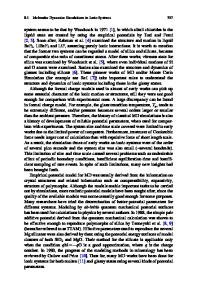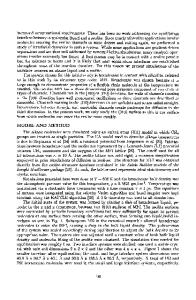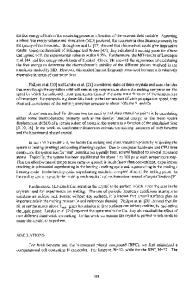Molecular Dynamics Simulations of Hypervelocity Buckminsterfullerene Collisions
- PDF / 338,934 Bytes
- 6 Pages / 414.72 x 648 pts Page_size
- 75 Downloads / 354 Views
lone and Milani performed MD simulations on C59/C 5 9 , C5 9/C 60 , and C60/C 6 0 collisions at very low collision energies (approximately 1/3 eV) and only observed fusion in collisions between the more reactive C59 clusters at these low impact energies [10]. In this paper we report results of extensive molecular dynamics simulations of high energy collisions between combinations of C60 and C7 0 clusters to study the threshold for molecular fusion [8]. These simulations show that cluster collisions with a zero impact parameter show a 50% probability for fusion at 120-130 eV collision energies in accord with the experimental results and MD studies using tight-binding methods [9]. MODEL AND METHOD The fullerene clusters are modeled using a bond-order type empirical hydrocarbon potential [10] which accurately predicts the bonding and energetics of solid diamond lattices and graphite sheets, as well as hydrocarbon molecules, while still allowing reactions to occur. The ability of this potential energy surface to allow reactions is crucial for these simulations to allow for possible fusion and/or fragmentation of the colliding clusters. This potential has previously been shown to provide a good model for a wide variety of properties of fullerenes and related structures [4,11-14], including simulations of the collision of C60 with a hydrogen-terminated diamond (111) surface [4]. This potential has also been used in a series of friction simulations involving diamond surfaces [15-17]. 199 Mat. Res. Soc. Symp. Proc. Vol. 359 01995 Materials Research Society
The constant energy MD simulations are performed by integrating Newton's equation of motion with an accurate high-order Nordsieck predictor-corrector method [18]. The clusters are equilibrated at an internal temperature of 750 K to match conditions similar to experimental studies. The initial conditions for a given trajectory are generated by randomly rotating the clusters, placing them 2 unm apart and then giving each cluster a center-of-mass velocity towards each other to generate the required impact energy. Most of the simulations were performed with an impact parameter of zero, i.e. headon collisions. These trajectories were then followed for 2 ps, after which time the trajectories were classified as to whether or not the clusters had fused. If the clusters did not fuse then the loss of translational energy to internal energy was calculated to obtain the degree of elasticity exhibited by the cluster collision. These simulations were performed for collisions between combinations of C60 and C70 clusters at impact energies of 50 to 180 eV.
RESULTS The results for the simulations involving collisions with zero impact parameter are summarized in Figure 1.
100
80
60
40
20
0 80
100
120 140 Collision Energy (eV)
160
Figure 1. Plots of the percentage of zero-impact-parameter trajectories resulting in molecular fusion are plotted by the solid lines and the relative amounts of translational energy retained after these collision are plotted by the dashed lines for C
Data Loading...











